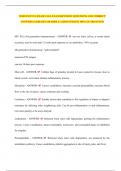NURS 5315 UTA EXAM 2 ALL EXAM REVISION QUESTIONS AND CORRECT
ANSWERS (ALREADY GRADED A+) (2024 UPDATE) 100% GUARANTEED
HIV EIA (3rd generation immunoassay) - ANSWER- can use urine, saliva, or serum (most
accurate), need to wait until 12 weeks post exposure to see antibodies, >99% accurate
4th generation immunoassay- "gold standard"
measures P24 antigen
can test 10 days post exposure
Mast cell - ANSWER- Cellular bags of granules located in loose connective tisssue close to
blood vessels. Activation initiates inflammatory process.
Histamine - ANSWER- Causes vasodilation, increases vascular permeability, increases blood
flow to the site of injury- causes erythema and swelling.
Cytokines - ANSWER- Soluble factors that contribute to the regulation of innate or adaptive
resistance by affecting other neighboring cells. Can be pro-inflammatory or anti-inflammatory.
Can react quickly or be more delayed.
Leukotrines - ANSWER- Released when mast cells degranulate, prolong the inflammatory
process. Cause vasodilation, attract neutrophils, monocytes, and eosinophils.target of inhibition
for singular.
Prostaglandins - ANSWER- Released when mast cells degranulate, are produced by the
arachidonic pathway. Cause vasodilation, platelet aggregation at site of injury, pain, and fever.
,Chemotactic factors - ANSWER- Biochemical substance that attracts leukocyte to the site of
inflammation
Neutrophils - ANSWER- Predominant leukocyte at work during the early stages of acute
inflammation
Monocytes - ANSWER- Become macrophages when entering the tissue, responsible for
presenting antigens to the CD4 cell which triggers T-cell immunity and B-cell immunity.
Releases additional cytokines IL1, IL6, TNF.
Cytokine IL1 function - ANSWER- Causes fever, activates phagocytes & lymphocytes and
also increases the release of IL6a
Cytokine IL6 function - ANSWER- Stimulates production of acute phase reactants and
promotes growth and stimulation of RBCs
Cytokine TNF function - ANSWER- Causes fever, increases synthesis of proinflammatory
proteins by liver, causes muscle wasting, induces thrombosis
Cytokine growth factor function - ANSWER- Promotes production and maturation of
neutrophils
Complement - ANSWER- Functions include bacterial lysis, vasodilation and increased
vascular permeability, triggers mast cell degranulation, chemotaxis, and opsonization.
Kinin - ANSWER- Converted to bradykinin which is responsible for pain and chemotaxis, and
it increases vascular permeability and vasodilation.
, Coagulation cascade - ANSWER- Factor XII activates kinin. Function is to form fibrin mesh
to stop bleeding and trap micro organisms.
COX1 - ANSWER- Prostaglandin of arachidonic pathway. Provides gastroprotection, platelet
aggregation, fluid/electrolyte balance
COX2 - ANSWER- Prostaglandin of arachidonic pathway. Responsible for pain, fever, renal
protection, tissue repair, reproduction development.
COX2 inhibitors- clinical implications - ANSWER- Protect gastric mucosa- prevent ulcers and
bleeding. Removed from market r/t cardiac events except for Celebrex. Can impair renal function
, monitor labs.
Arachidonic pathway purpose - ANSWER- Synthesis of prostaglandins
Non-selective NSAIDS - ANSWER- Inhibit COX1 and COX2, risk for gastric ulceration, GI
bleeds, edema, renal impairment
ASA - ANSWER- Blocks COX1 and COX2, also inhibits Thromboxane A2 and prostaglandins
Corticosteroids - ANSWER- Inhibit phospholipase A2, preventing formation of prostaglandins,
thromboxane A2, prostacyclin, and leukotrines
Thromboxane - ANSWER- Vasoconstriction, platelet aggregation
Prostacyclin - ANSWER- Vasodilation, platelet aggregation (most effective one)
Type 1 hypersensitivity - ANSWER- E. Immediate response to allergen, food, meds, pollen,
asthma, allergic reactions




